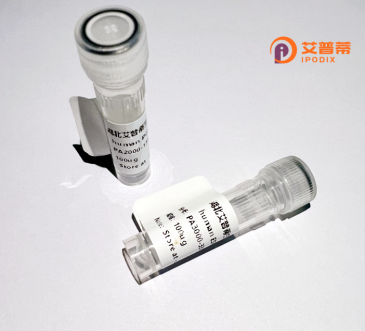
| 纯度 | >90%SDS-PAGE. |
| 种属 | Human |
| 靶点 | SUV39H2 |
| Uniprot No | Q9H5I1 |
| 内毒素 | < 0.01EU/μg |
| 表达宿主 | E.coli |
| 表达区间 | 1-410 aa |
| 活性数据 | MAAVGAEARG AWCVPCLVSL DTLQELCRKE KLTCKSIGIT KRNLNNYEVE YLCDYKVVKD MEYYLVKWKG WPDSTNTWEP LQNLKCPLLL QQFSNDKHNY LSQVKKGKAI TPKDNNKTLK PAIAEYIVKK AKQRIALQRW QDELNRRKNH KGMIFVENTV DLEGPPSDFY YINEYKPAPG ISLVNEATFG CSCTDCFFQK CCPAEAGVLL AYNKNQQIKI PPGTPIYECN SRCQCGPDCP NRIVQKGTQY SLCIFRTSNG RGWGVKTLVK IKRMSFVMEY VGEVITSEEA ERRGQFYDNK GITYLFDLDY ESDEFTVDAA RYGNVSHFVN HSCDPNLQVF NVFIDNLDTR LPRIALFSTR TINAGEELTF DYQMKGSGDI SSDSIDHSPA KKRVRTVCKC GAVTCRGYLN |
| 分子量 | 46.6 kDa |
| 蛋白标签 | His tag N-Terminus |
| 缓冲液 | PBS, pH7.4, containing 0.01% SKL, 1mM DTT, 5% Trehalose and Proclin300. |
| 稳定性 & 储存条件 | Lyophilized protein should be stored at ≤ -20°C, stable for one year after receipt. Reconstituted protein solution can be stored at 2-8°C for 2-7 days. Aliquots of reconstituted samples are stable at ≤ -20°C for 3 months. |
| 复溶 | Always centrifuge tubes before opening.Do not mix by vortex or pipetting. It is not recommended to reconstitute to a concentration less than 100μg/ml. Dissolve the lyophilized protein in distilled water. Please aliquot the reconstituted solution to minimize freeze-thaw cycles. |
以下是与重组人SUV39H2蛋白相关的3篇代表性文献,涵盖其功能、结构及表达研究:
---
1. **文献名称**: *Regulation of chromatin structure by site-specific histone H3 methyltransferases*
**作者**: Rea, S. et al.
**摘要**: 该研究首次鉴定SUV39H2为哺乳动物组蛋白甲基转移酶,证明其特异催化H3K9三甲基化,参与异染色质形成和转录沉默,并通过重组蛋白实验验证其体外酶活性。
2. **文献名称**: *Structural basis for the methylation site specificity of SUV39H2*
**作者**: Collins, R. E. et al.
**摘要**: 通过重组表达并解析SUV39H2的晶体结构,揭示其底物识别机制,阐明其特异性靶向H3K9的分子基础,为表观遗传药物设计提供依据。
3. **文献名称**: *SUV39H2 interacts with HP1 proteins for heterochromatin assembly*
**作者**: Yamada, T. et al.
**摘要**: 利用重组SUV39H2蛋白进行体外结合实验,证实其与HP1蛋白相互作用,协同调控异染色质形成及基因沉默功能,揭示其在表观遗传调控网络中的关键角色。
---
如需更多应用性研究(如疾病关联),可补充近期文献。早期研究(如Rea et al. 2000)仍为该领域的奠基性工作。
SUV39H2. a member of the SUV39H subfamily of histone methyltransferases, plays a critical role in epigenetic regulation by catalyzing the methylation of histone H3 at lysine 9 (H3K9). This enzyme is structurally characterized by a conserved SET domain responsible for its catalytic activity and an N-terminal chromodomain that facilitates chromatin binding. It contributes to heterochromatin formation, gene silencing, and maintenance of genomic stability through interactions with other chromatin-modifying complexes. SUV39H2 is closely related to SUV39H1 but exhibits distinct expression patterns, with SUV39H2 showing broader tissue distribution and potential roles in development and cell cycle regulation.
Recombinant human SUV39H2 protein is commonly produced in bacterial or mammalian expression systems to enable in vitro studies of its enzymatic mechanisms, substrate specificity, and regulatory networks. Its recombinant form has become a vital tool for investigating epigenetic dysregulation in diseases such as cancer, where altered H3K9 methylation is linked to tumorigenesis. Researchers also utilize it to screen small-molecule inhibitors targeting aberrant histone methylation, with therapeutic implications for age-related disorders and chromatinopathies. The protein’s biochemical characterization continues to advance understanding of how dynamic chromatin modifications influence cellular identity and disease pathways.
×